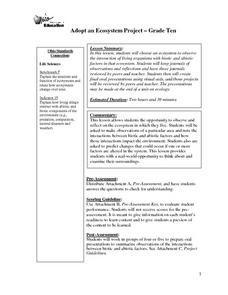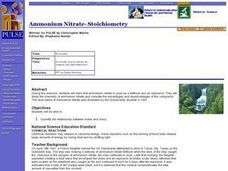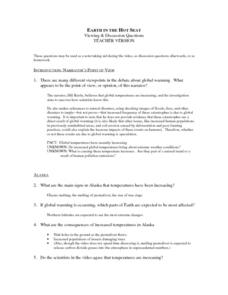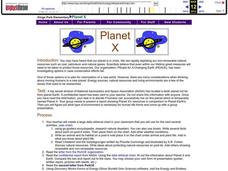Project SMART
Rocks and Minerals: Touch the Earth
Students complete a unit of lessons on rocks and minerals. They conduct research, write e-mail questions to geologists, write daily journal entries, label maps demonstrating types of rocks/minerals found, and create a web page that...
Curated OER
Adopt An Ecosystem
Tenth graders choose an ecosystem to observe the interaction of living organisms with biotic and abiotic factors in that ecosystem. They keep journals of observations and reflections in order to have a resource for further...
Curated OER
Hurricanes
Students use the internet to research the characteristics of hurricanes. Using this information, they read about past hurricanes and use a weather map to trace current disturbances in the oceans. They also discuss hurricane safety and...
Curated OER
The Robots are Coming
In this robots instructional activity, students read a 6-paragraph article about robots and robotics and respond to 4 short answer questions regarding the article. Vocabulary words from the article and their definitions are also included.
Curated OER
Electricity and Lightning
Young scholars define important vocabulary words related to electricity and charges. In this physics lesson, students examine force created by electricity and lightning. They differentiate between the two forces and how they both...
Curated OER
Plate Tectonic - Volcanoes (1)
Students learn the different shapes of Volcanoes and discuss why volcanoes only have a few shapes.
Curated OER
Cranes, Crosswalks, and Big Gulps
Students watch a video and answer questions based on wildlife jobs. In this wildlife lesson plan, students learn that biologists don't just play with animals but that there is a lot of study involved.
Curated OER
Ammonium Nitrate - Jeckyl or Hyde
Students study how chemicals can be very dangerous when not treated with care. They watch Ammonium Nitrate power point and read about accidents involving ammonium nitrate: Halifax Explosion, Oklahoma City Bombing.
Curated OER
Radiation: To Worry or Not to Worry
Students distinguish safe forms of radiation from those that are dangerous. Students watch a video about sources of radiation encountered every day. Students estimate their own annual radiation exposure.
Curated OER
Radiation: To Worry or Not to Worry
Learners distinguish safe forms of radiation from those that are dangerous. Students watch a video about sources of radiation encountered every day. Learners estimate their own annual radiation exposure.
Curated OER
The Lesson: Species Under Threat
Students consider the plight of endangered species. In this global studies lesson, students research selected websites about endangered animals and identify global issues that contribute to their demise.
Curated OER
Ammonium Nitrate - Efficient Fertilizers
Students study the chemistry of ammonium nitrate and consider the advantages and disadvantages of this compound. They compare different fertilizers and calculate the molar mass and percent nitrogen in the different fertilizers.
Curated OER
Ammonium Nitrate- Stoichiometry
Students quantify the relationship between moles and mass. They comprehend that ammonium nitrate is used as a fertilizer and an explosive. Students study the chemistry of ammonium nitrate and consider the advantages and disadvantages of...
Curated OER
Toothpick Fish
Young scholars experiment with genes and environment for a population of "Toothpick Fish."
Curated OER
Got Water?
Students determine that delivering clean, fresh water to citizens around the world involves and affects politics, economics, international relations, and technology. They brainstorm a list of factors that might affect their town's...
Curated OER
NASA's Mars gamble pays off
Students read an article about NASA and Mars and complete short answer questions about the article. In this Mars lesson plan, students also create a scale model of the solar system.
Curated OER
Coastal Quandary
Students explore the debate among development and environment experts on evacuation coastal areas and take part in their own debate on "evacuation versus redevelopment".
Curated OER
How Did This Happen?
Pupils use websites and discussion to investigate the 2004 Asian Tsunami. Students identify the Indian Ocean coastline's physical, political and human geography features and consider how they affected loss of life and property in those...
Curated OER
Earth in the Hot Seat
Young scholars identify the different viewpoints on the issue of global warming. While watching a video, they take notes on the issues presented to them and answer questions about what Alaska, Peru and East Africa are doing to prevent...
Curated OER
People & Trees
Students see that people have developed new technologies and new products that increase efficiencies and maximize the productive use of each tree harvested. This lesson provides many good ideas across the curriculum to study forestry.
Curated OER
Planet X
Students select a wide variety of presentation methods to compare Planet X and Earth. Students share these with their classmates. Students select other methods to present their ideas about a livable planet for human life forms. ...
Curated OER
Surveying an Environment / Ecosystem
Young scholars visit a local ecosystem to survey the plants and animals present and identify interactions between organisms. They identify interactions that occur between living organisms and their ecosystem and present their ecosystem...
Curated OER
The Water Dilemma
Students read about and discuss the importance of easily available, clean drinking water. They participate in a role play scenario in which only one drinking fountain in the school has potable water.
Curated OER
Hurricanes Katrina and Rita: Stories To Be Told
Students listen to stories about the tradegies of Hurricane Katrina and Rita. Using their own experiences from the hurricanes, they try to put their own story into words. They are to focusing on getting the information and their feelings...

























